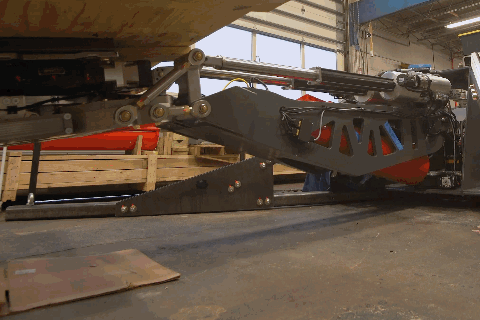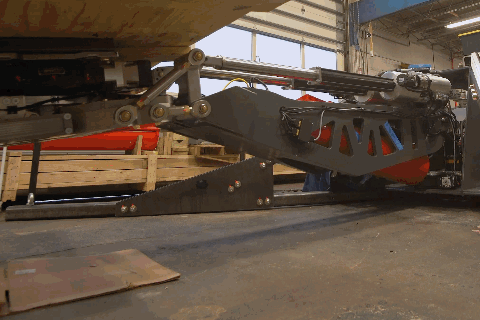.bh__table_cell { padding: 5px; background-color: #FFFFFF; }
.bh__table_cell p { color: #2D2D2D; font-family: ‘Helvetica’,Arial,sans-serif !important; overflow-wrap: break-word; }
.bh__table_header { padding: 5px; background-color:#F1F1F1; }
.bh__table_header p { color: #2A2A2A; font-family:’Trebuchet MS’,’Lucida Grande’,Tahoma,sans-serif !important; overflow-wrap: break-word; }
I’m excited to premiere our first ‘Deep Tech Deep Dive’, in which you can join me behind the facility doors of science-advantaged startups to examine how particular teams are using engineering, business, and design to solve tough challenges. This issue of Telemetry is inspired by my newly-released feature video Beyond Hydraulics, a focus on RISE Robotics. Check out the 1-minute trailer and visit the thrust page.
– Jonathan “JMill” Miller

Was this email forwarded to you? Sign up for Telemetry.
Hydraulics and Heavy Industry
When driving along highways in the summertime, I routinely see construction crews maintaining roadways, building bridges, and conducting other functions necessary to support critical infrastructure. All of the vehicles, from the diggers to the dumpers, are able to do their ‘work function’ via actuation. With few exceptions, that actuation occurs with hydraulic action, pumping toxic oils through high-pressure hoses to move large pieces of metal away from or closer to each other. These movements of lifting and lowering staggering amounts of mass is the figurative foundation of heavy industry. Currently, hydraulic machines are the most effective mechanisms for constructing buildings, boring underground tunnels, establishing offshore drilling platforms, cultivating agriculture at scale, and pretty much every other industrial application.
Innovator’s Case: Belts → Hydraulics
What began in the 1930s and wholly complete by the 1990s, hydraulics replaced belt-driven machines, the former mainstay of the industrial era. Powered by a central steam engine or an electric motor, belt-driven machines were particularly useful in factories and mills since they were efficient for large-scale manufacturing in which one energy source powers multiple machines. No longer would an aspiring industrialist need to pair n number of mules to 1 machine.

Ceiling-mounted antique belt drive system for a workshop. Via National Mississippi Museum & Aquarium
In The Innovator’s Dilemma, Clayton Christensen discusses how disruptive technologies often start as inferior products in the eyes of established market leaders but eventually overtake them by fulfilling emerging needs more effectively. The science of hydraulics effectively supplanted belt physics, since belt-driven machines were cumbersome, limited in their precision and inflexible in the application areas they could serve. In contrast, the emerging field of hydraulic machines provided greater precision, safer operation, lower maintenance and higher duty cycles. So the market shifted, leaving companies that continued to rely solely on belt-driven systems at a competitive disadvantage. The shift to hydraulic systems became essential for remaining competitive in the evolving industrial landscape.
Are hydraulics here to stay? In many application areas, not necessarily so. With most dominant designs engineered in the 1970s, a growing problem with hydraulic machines is that they are not readily ‘digitizable’. Reindustrialization, the competitive modernization of heavy industry, must consider that machine intelligence enabled by advanced compute capabilities requires robot-like system architectures that are fundamentally digital in their sensor payloads, decision-making pipeline, and planning / control components.

Example of an electrified belt-driven actuator’s real-time interface showing duty cycle, loading, and other parameters of interest crucial for preventative maintenance and industrial robot systems. Via RISE Robotics
Industrial Robot System Architecture
Most robots to-date rely on electric motors including steppers, servos, brushless direct current, piezoelectrics, and several other approaches. While there is effort to increase the capabilities of several of these motor types to accommodate the challenges commonly faced in heavy industry, issues such as efficiency (for brushed DC motors), heat dissipation (for brushless DC motors), and bulk (for induction motors) are currently dealbreakers.
If hydraulic machines have inherent limitations for modernization and electric motors have significant design challenges to overcome, it suggests that we as technologists should continue exploring alternative approaches to enable the benefits of digital actuation in heavy industry so human operators and their machines are more effective, more coördinated, and more sustainable.
Years ago, the co-founders at RISE Robotics were exploring the problem sets facing present and future machines, including exosuits and other enhancements to natural human movement. Their systematic work pursuing mechanical advantage led them to actuation, specifically to novel approaches for packing belts into very compact, efficient, non-planar arrangements that can be squeezed into a familiar shape that is akin to a hydraulic linear actuator but features different balance-of-plant. For example, these RISE cylinders, show in red in the image below, enable regenerative load capture that enables striking amounts of energy efficiency compared to contemporary approaches.

Employees discussing a belt tester that is used to characterize actuators in a range of operating conditions. Photo by JMill
These mechanical marvels can rival and surpass the performance of hydraulics, the dominant approach for giving our machines the ability to push, pull, lift, and lower payloads. But how is this team designing, building, and evolving their capabilities? How are they growing the company? I examine these topics and more with the founders and staff of RISE Robotics.
Focus: RISE Robotics
From the company’s inception and their early prototypes like jump boots and exosuits, to the development of multi-ton robotic arms and forklifts, I take an in-depth look at their journey. Learn about their unique approach to electrification, enjoy interviews with key team members, and learn how RISE is integrating their technology into various industrial applications. We even get a sneak peak at a powerful new robotic arm that may soon hold a world record!
Actuation is the key component for making machines move. This is 100% analogous with muscles on animals. With an innovative belt-drive system that looks like a hydraulic cylinder but functions like a high-precision motor, RISE belt-actuated cylinders could be the future of mobility in heavy industry. I cover all of this and more in the full length video.
Tough Tech Takeaways
Below I summarize three of several “tough tech takeways“ that are beneficial to any science-advantaged startup.
-
Prioritize tests to determine what physics allows. Be serious about collecting empirical data associated with each designs across a range of potential use-scenarios. (Corollary: document and index this data so it becomes accumulated information that is accessible to ‘future you’.)
-
Integrate industrial design as early as possible. Engineers, designers, business managers, and other functions have different mindsets, so do not risk mental foreclosure by excluding diverse viewpoints from ‘having a seat at the table’.
-
Effectively applied, a robotic system architecture improves the future of work by making novice human operators good enough, and empowers expert human operators to become superhuman. The heavy industrial robotics platforms enabled by RISE actuators can and should enable safer, more efficient, more sustainable equipment operations.
Watch now
Chapter timecodes and additional links are available on the thrust page. The trailer is viewable below:
The full-length video (43 minutes) can be watched here:
👑 Deep Tech Dialogues with RISE Robotics
Our “read in” members of The End Effector have access to the following fully-produced video interviews and walkthroughs with the RISE Robotics team. Lots of content in these videos if you’re interested in the topics above!
👑 🎥 Introduction to Belt-Powered Systems (11 minutes)
👑 🎥 Revolutionary Belt Testing: Enhancing Durability and Efficiency (31 minutes)
👑 🎥 Real-Life Wearable Machines and Advanced Actuation Technologies (27 minutes)
👑 🎥 The Balancing of Project, People, and Money in Technology Development (31 minutes)
👑 🎥 The Future of Aircraft Munitions Handling: The Six Degree of Freedom Arm (23 minutes)
👑 🎥 Robot World Record Attempt and the Push-Pull Actuation Test Fixtures to Get It Done (14 minutes)
Below is cover art for each of the bonus videos.
No One Builds Alone.
/N1BA
Telemetry is written by JMill of The End Effector.
Home | Partner | Membership
Questions, feedback? Let me know by replying to this email.












